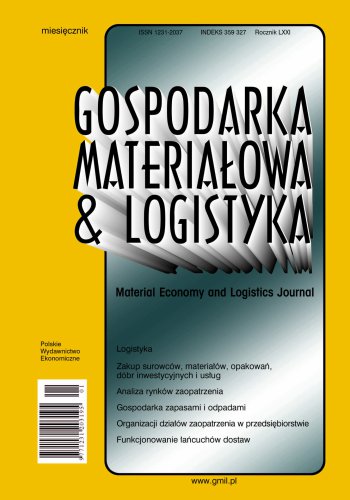Directions of modification of supply chain management in the perspective of the future
The aim of the article is to assess the condition and indicate future transformations of international supply chains. The method of analysis and critical assessment of the state as well as a projection of changes in the studied field were used. The COVID-19 pandemic and the military aggression against Ukraine should be considered a major turning point that changes the way people think about shaping and managing international supply chains. The current standard of their management, based on a parasitic pursuit of often undue financial surplus, should be redefined. It is postulated to strive for the formation of symbiotic chains of relationship management that contribute to the socio-economic modernization of less developed countries. To be also expect projects to build a greater degree of resilience of these chains by less stringent treatment of the need to lean the chains and to a greater degree to green them. When also aiming to reduce economic risk, the length of transport corridors should be expected to be minimized, which means the geographical relocation of companies forming supply chains.
References
Bibliografia/References
Banaszyk, P. (2020). The effectiveness criteria from the enterprise management and supply chain management perspective. Gospodarka Materiałowa i Logistyka, (6). https://doi.org/10.33226/1231-2037.2020.6.1
Banaszyk, P., & Fimińska-Banaszyk, R. (2016). Symbiotic and parasitic supply chains. Research in Logistics and Production, 6(5). https://doi.org/10.21008/j.2083-4950.2016.6.5.7
Banaszyk, P., & Gorynia, M. (2021). Pandemia COVID-19 a konkurencyjność przedsiębiorstwa. W: M. Gorynia (red.), Świat w obliczu pandemii. CeDeWu.
Baraniecka, A., & Zięba-Szewczyk, S. (2018). Społeczna odpowiedzialność biznesu w zarządzaniu łańcuchami dostaw. Marketing i Rynek, (11).
Barney, J. (1991). Firm resources and sustained competitive advantage. Journal of Management, 17(1).
Bedianashvili, G. (2021). Macroeconomic and cultural determinants of the COVID-19 pandemic crisis. Bulletin of the Georgian National Academy of Sciences, 15(2).
Bekaert, G., Engstrom, E., & Ermolov, A. (2020). Aggregate demand and aggregate supply effects of COVID-19. A real-time analysis, https://www.federalreserve.gov/econres/feds/files/2020049pap.pdf (dostęp 17.12.2021). https://doi.org/10.2139/ssrn.3611399
Brilman, J. (2002). Nowoczesne zarządzanie. Koncepcje i metody. PWE.
Brown, J., Sackett, P., & Wortmann, J. (1995). Future manufacturing systems — towards the extended enterprise. Computer in Industry, (25). https://doi.org/10.1016/0166-3615 (94)00035-o
Duliniec, A. (2012). Koszt kapitału w teorii i praktyce przedsiębiorstw. Gospodarka Narodowa, (3). https://doi.org/10.33119/gn/100998
European Commission. (2021). Autumn 2021 economic forecast: From recovery to expansion, amid headwinds. https://ec.europa.eu/info/business-economy-euro/economic-performance-and-forecasts/economic-forecasts/autumn-2021-economic-forecast_pl (dostęp 17.12.2021).
Gereffi, G., Humphrey, J., & Sturgeon, T. (2005). The governance of global value chains. Review of International Political Economy, 12(1). https://doi.org/10.1080/09692290500049805
Gereffi, G., & Fernandez-Stark, K. (2011). Global value chain analysis: A primer. Center of Globalization. Governance and Competitiveness. https://www.researchgate.net/publication/265892395_Global_Value_Chain_Analysis_A_Primer (dostęp 28.12.2021). https://doi.org/10.4337/9781788113779.00008
Grzegorczyk, M. (2022). UNCTAD szacuje wpływ wojny na handel i rozwój. Puls Biznesu, (53/6062).
Has the pandemic shown inflation to be a fiscal phenomenon? (2021). The Economist, 18.12.2021, https://www.economist.com/financeand-economics/2021/12/18/has-the-pandemic-shown-inflation-to-be-a-fiscal-phenomenon (dostęp 21.12.2021).
Humphrey, J., & Schmitz, H. (2001). Governance in Global Value Chains. IDS Bulletin, 32(3). https://doi.org/10.1111/j.1759-5436.2001.mp32003003.x
Kudełko, M. (2016). Korygowanie niekorzystnych efektów zewnętrznych. Journal of Management and Finance, 14(3).
Lamming, R., Johnsen, T., Zheng, J., & Harland, C. (2000). An initial classification of supply networks. International Journal of Operations and Production Management, 20(6).
Massood, A. (2021). COVID-19 impact on consumer behaviour, demand and consumption. International Journal for Innovative Research in Multidisciplinary Field, 7(1).
Panwar, R., Pinkse, J., De Marchi, V. (2022). The future of global supply chains in a post-COVID-19 world. California Management Review, 64(2). https://doi.org/10.1177/00081256211073355
Skarżyńska, A. (2012). Rachunek kosztów działań — nowe spojrzenie. Zagadnienia Ekonomiki Rolnej, (3/332).
Yuchtman, E., & Seashore, S. (1979). Efektywność organizacji w świetle zasobów systemu. W: Zachowania człowieka w organizacji. PWN.
Waters, D., Rinsler, S., (2010). Global logistics. New directions in supply chain management, Kogan Page.
Williamson, O. (1998). Ekonomiczne instytucje kapitalizmu. Firmy, rynki, relacje kontraktowe. Wydawnictwo Naukowe PWN.

